
Summer is here! Is there anything better than lunch on a sunny day in San Francisco? Call me biased, but celebrating life’s simple pleasures has taken on more significance to me this year. I’ve been revisiting my favorite spots and soaking up the sun. Plow is always a treat, and if you’ve got any suggestions, let me know!
So this month’s newsletter focuses on macroeconomic policy on the United States and the money supply. Last year, the sky was falling and we started to see huge condo supply and single family homes getting snatched up; apparently San Francisco was dead in the water.
Well, with over 15 years in San Francisco Bay Area real estate under my belt, I’ve learned to wait and see before joining the Chicken Little chorus. In 2008, we had an unprecedented financial collapse, and many of us faced an uncertain future. However, instead of packing up and moving out, I stuck around and watched as San Francisco was one of the first real estate markets to emerge from the chaos and start leading the way toward recovery.
This summer, the outlook for the next twelve months is good, and all those folks that have been saving their money over the pandemic are ready to spend. With interest rates at around 3%, many are looking to take advantage of a great opportunity. If you’ve been on the fence about buying or selling, we need to talk soon!
Don’t be a stranger, and give me a call for a consultation and need analysis for you or anyone you know. Be sure to get out and enjoy the summer, and if you want to grab brunch, I’m always game!
– Kevin Gueco, DRE #01461677
Welcome to our June newsletter, where we’ll dive into residential real estate trends in the Greater Bay Area and across the nation. This month, we examine how the money supply is affecting asset price valuations and interest rates.
The increase of money supply started accelerating around 2000 and, since that time, with the exception of the past couple of months, inflation has been extremely low. At the same time, asset prices, like stocks and real estate, have risen considerably. Low inflation suggests that consumers are saving more than they are spending on goods and services. With more money in circulation, interest rates drop. In fact, mortgage rates are hovering near all-time lows, just under 3%.
With low interest rates, more money in circulation, and fewer opportunities to spend money over the last year, homebuyers have flooded the market—and we expect this high housing demand to continue for at least the next 12 months. In addition, most potential buyers are flush with cash and have high credit scores, which has created an incredibly competitive environment and caused housing inventory to drop to historically low levels.
As we navigate this period of high buyer demand and low supply, we remain committed to providing you with the most current market information so you feel supported and informed in your buying and selling decisions. In this month’s newsletter, we cover the following:
- Key Topics and Trends in June: The supply of money in the United States has contributed to increasing asset prices, especially in the housing market.
- June Housing Market Updates for the Greater Bay Area: Single-family home prices reached all-time highs, highlighting the desirability of the area. Condo prices are increasing across most of the Greater Bay Area.
Key Topics and Trends in June
The past year saw the highest sales volume and fastest price increases on record, nationally. We want to take a closer look at this massive buyer demand, and the ways in which it’s affecting the housing market.
At the start of the pandemic, the housing market looked incredibly unstable: buyers and sellers were pulling out of deals, sales volume and inventory dropped, and unemployment skyrocketed. The uncertainty around the housing market was short-lived, however, and it became clear that homes were going to have a remarkable year.
The sheer number of highly qualified buyers who were entering the market seemed to come out of nowhere, and we were left wondering where all this money had been hiding before the pandemic. As we dug into the data, we saw that the money was out there, but people were simply not spending it.
The graph below shows the money supply (M2) in the United States and the velocity of money, which measures how much consumers and businesses are spending (higher velocity equates to more spending, and vice versa). When the money supply and velocity increase, we tend to see inflationary periods. As you can see from the chart, however, the money supply increased dramatically (3x) over the last 20 years, while velocity decreased. In other words, more money has not driven the equivalent production of more goods and services, implying that consumers are saving and/or investing. Over the last year, the money supply has increased even more because of COVID-19 relief and the Federal Reserve’s monetary policies, putting even more money in consumers’ pockets.
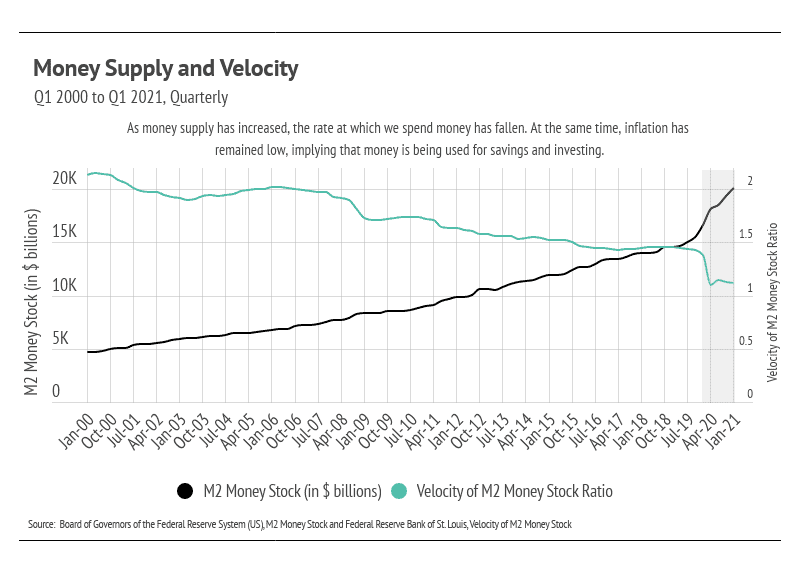
Using the S&P 500 and the housing market as examples, we can see the effect that the money supply has had, especially over the last year. The S&P 500 increased around 54% from March 2020 to March 2021, and the Case-Shiller 20-City Home Price Index, which measures the aggregate home prices in the 20 largest metro areas, rose 14%. Stock prices benefit considerably from increased money supply due to their liquidity and fungibility. Home prices rose substantially, especially considering their illiquid nature. Notably, we aren’t seeing a transfer of money out of stocks and into housing; rather, we’re seeing cash going into both asset classes, which means that there is a large amount of money in circulation.
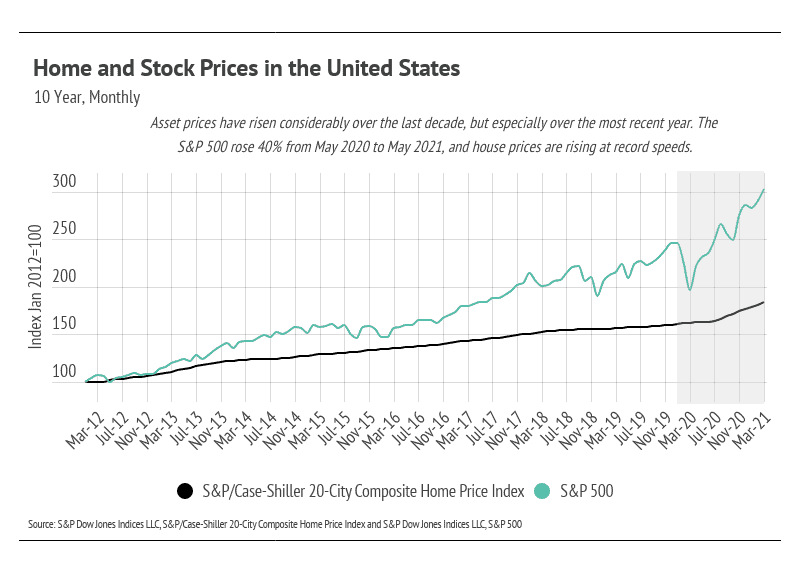
An increase in money supply also tends to lower interest rates. As shown in the chart below, mortgage rates have definitely declined over the last 20 years, and we’re currently hovering at historically low rates, which increases housing affordability despite the rising prices.
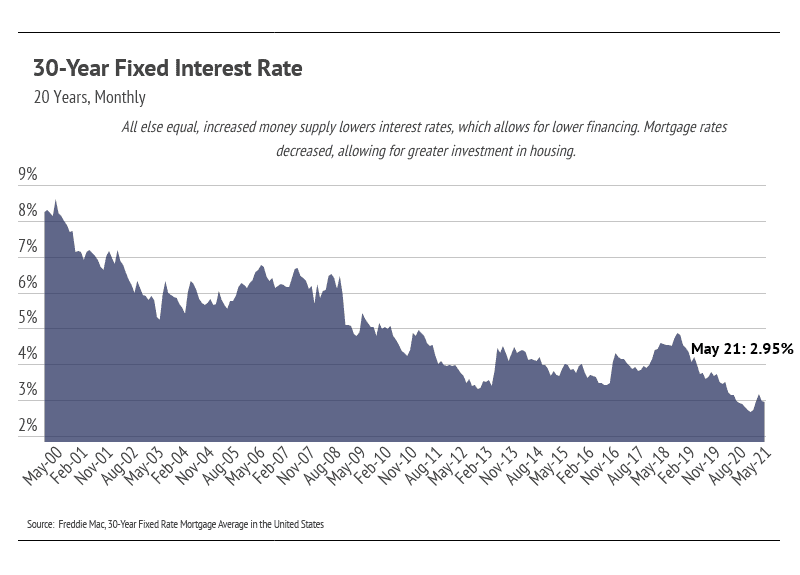
We don’t expect the same level of buying in 2021 that we saw in 2020, mostly because of the home undersupply issue. The environment, therefore, is right for demand to outpace supply in 2021. We’ve reached near-perfect conditions for buyers—high credit scores, large down payments, and low-rate financing—so we anticipate a competitive landscape for buyers throughout the year.
While the market remains competitive for buyers, conditions are making it an exceptional time for homeowners to sell. Low inventory means sellers will receive multiple offers with fewer concessions. Because sellers are often selling one home and buying another, it’s essential that sellers work with the right agent to ensure the transition goes smoothly.
June Housing Market Updates for the Greater Bay Area
During April 2021 in the Greater Bay Area, the median single-family home price rose to another all-time high. Year-over-year, Greater Bay Area prices increased considerably, up 36%.
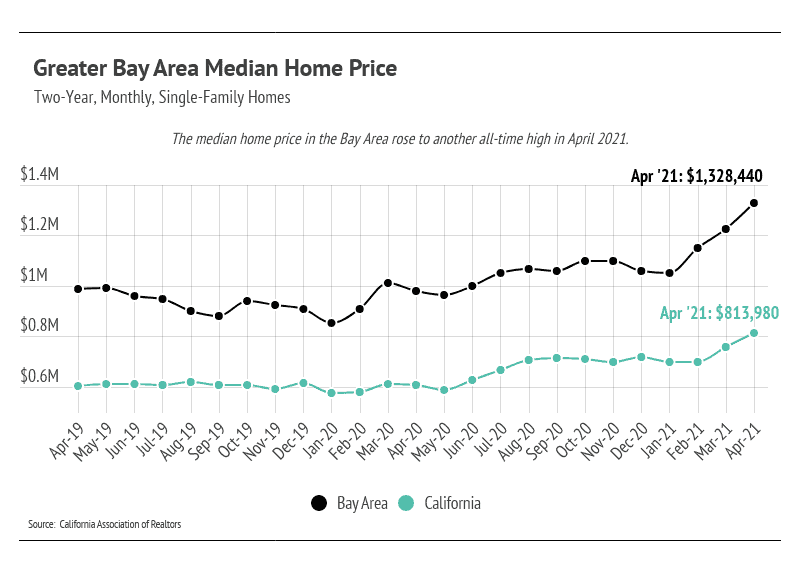
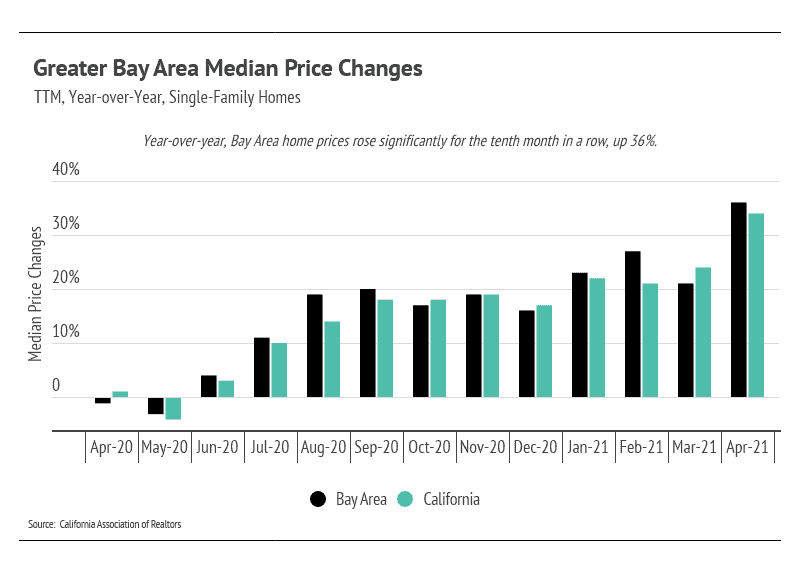
The median price in all four regions of the Greater Bay Area rose to all-time highs in April. The sustained price appreciation emphasizes the demand in the area.

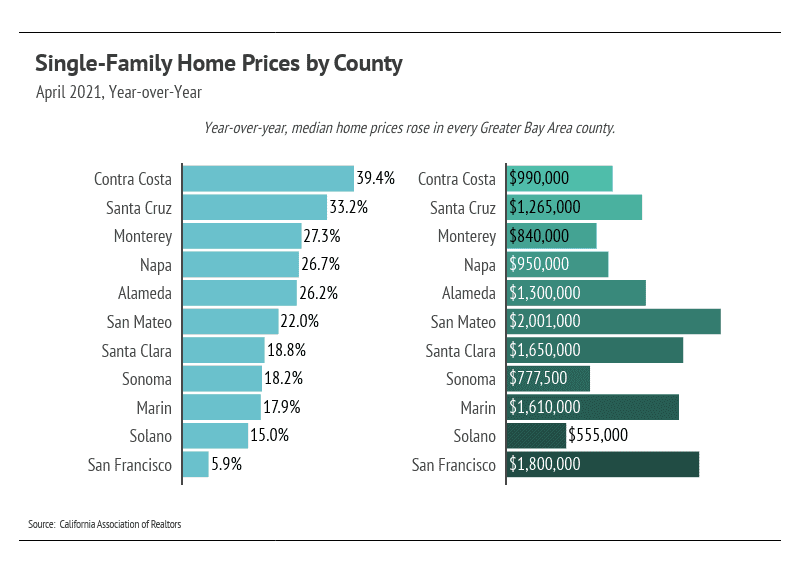
As you can see in the graphs below, median condo prices were mixed across regions and counties. San Francisco condo prices declined month-over-month, while the rest of the Bay regions rose slightly.
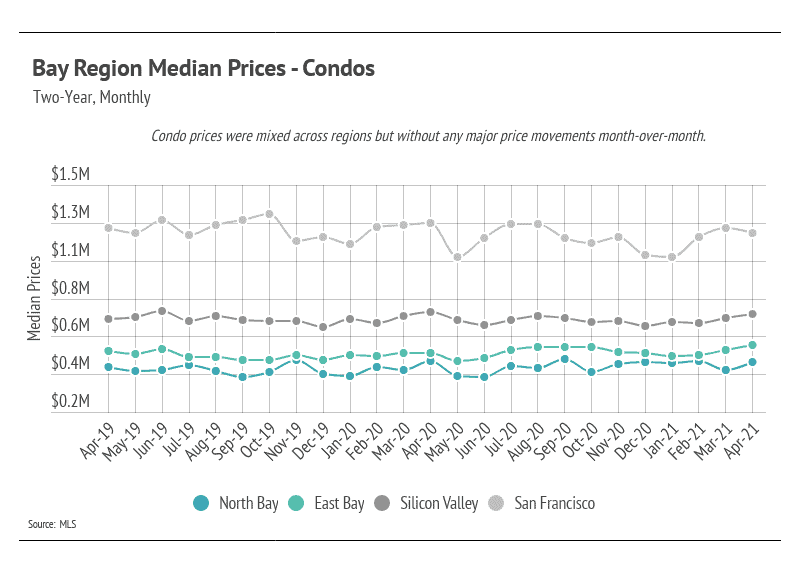
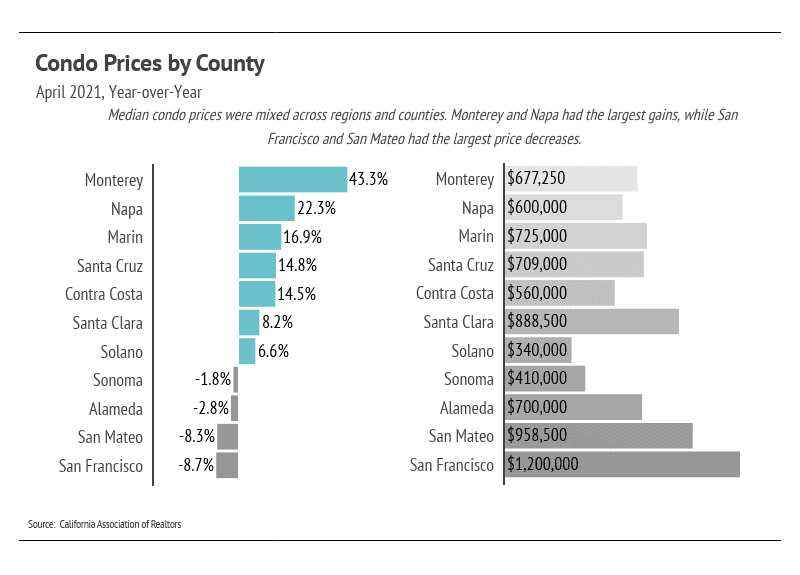
Single-family home inventory began to climb over the last three months, which is expected in the spring/summer season when more sellers typically come to market. In 2020, fewer people wanted to leave the Greater Bay Area, and more people wanted to move to the area. This trend drove inventory down to record low levels. New listings, therefore, improve the current market conditions. In April 2021, the total inventory in the Greater Bay Area had slightly more homes for sale than it did in April 2020, which is a positive development for the housing market. The sustained low inventory will likely cause prices to appreciate throughout 2021.
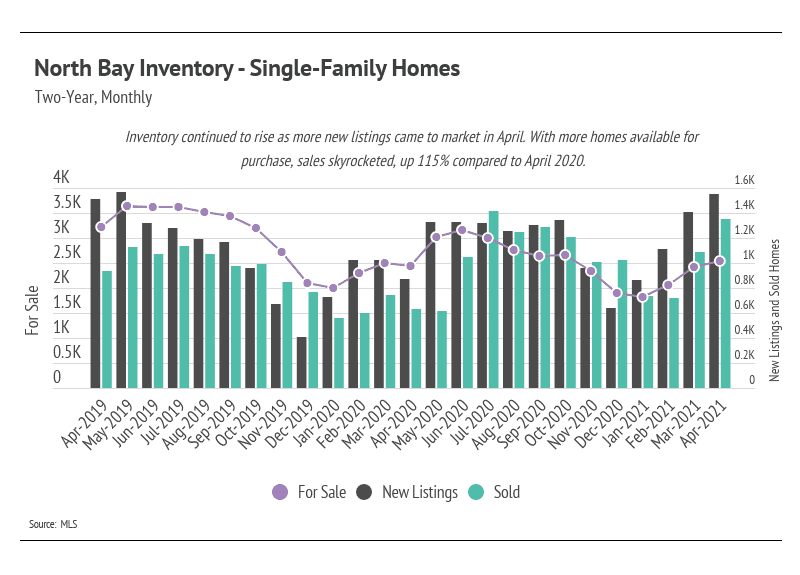
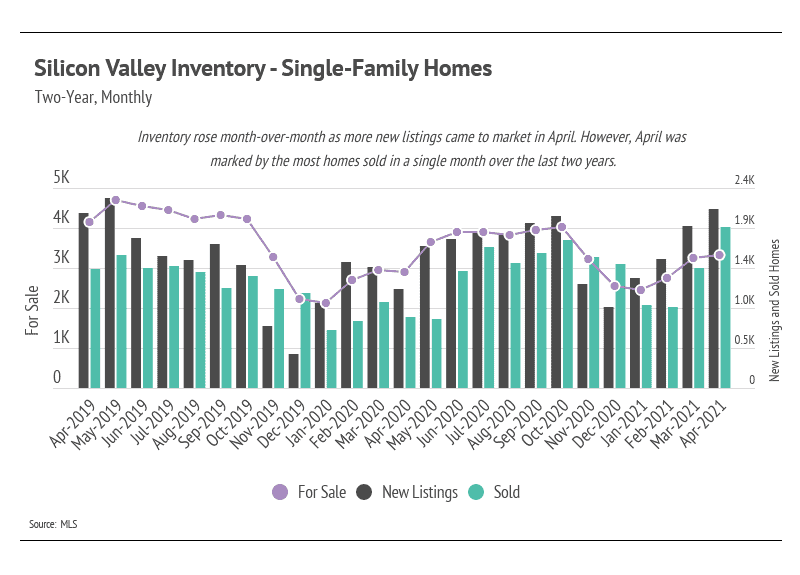
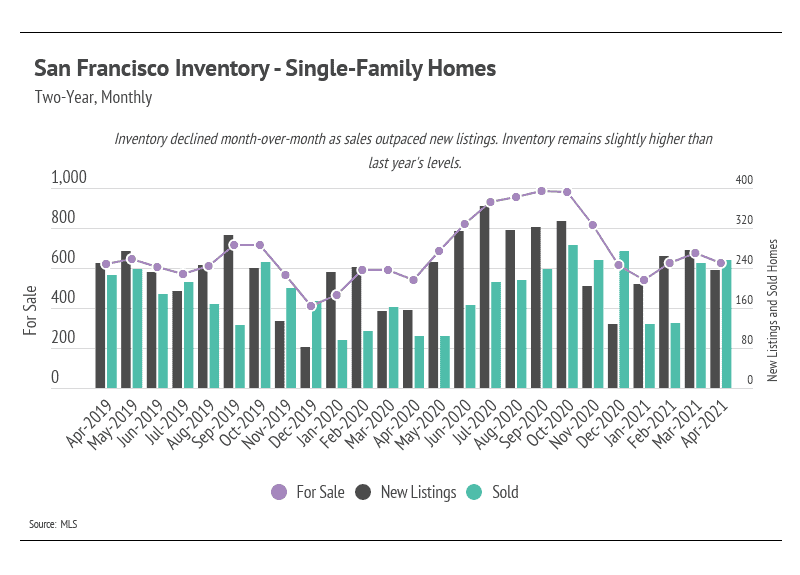
Both single-family homes and condos are selling quickly. As we will see, the pace of sales has contributed to the low Months of Supply Inventory (MSI) over the past several months.
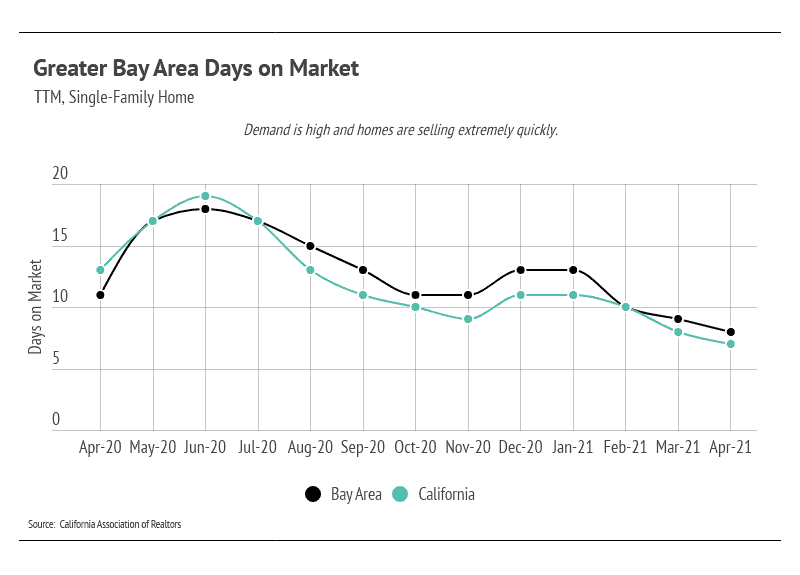
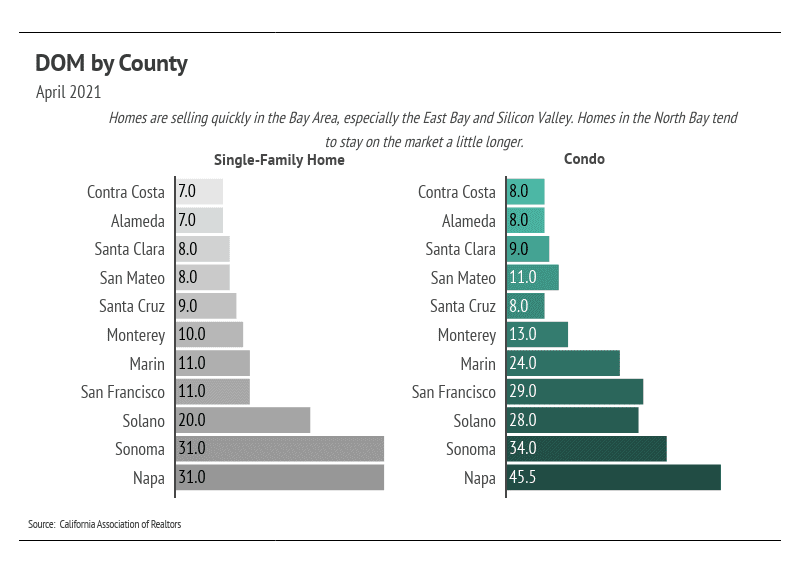
We can use MSI as a metric to judge whether the market favors buyers or sellers. The average MSI is three months in California (far lower than the national average of six months), which indicates a balanced market. An MSI lower than three means that there are more buyers than sellers on the market (meaning it’s a sellers’ market), while a higher MSI means there are more sellers than buyers (meaning it’s a buyers’ market). In April 2021, the MSI remained below two months of supply for single-family homes, indicating that the market strongly favors sellers.
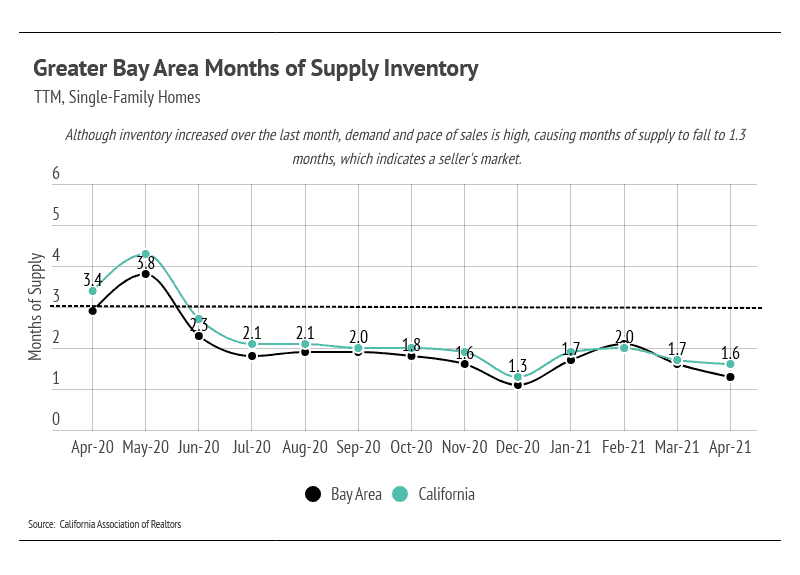
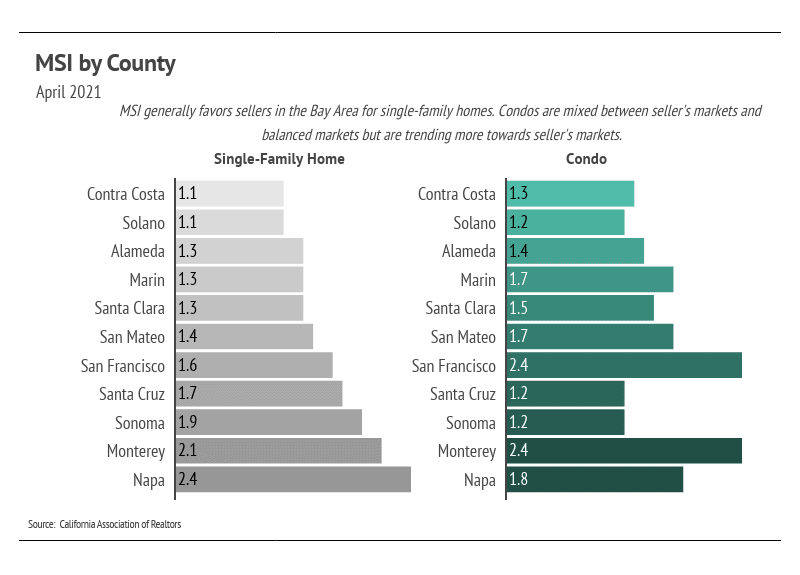
In summary, the high demand and low supply present in the Greater Bay Area have driven home prices up. Inventory will likely remain low this year with the sustained high demand in the area, potentially lifting prices higher. Overall, the housing market has shown its value through the pandemic and remains one of the most valuable asset classes. The data show that housing has remained consistently strong throughout this period.
We expect that the number of new listings will increase in the summer months.The current market conditions can withstand a high number of new listings coming to market, and more sellers may enter the market to capitalize on the high buyer demand. As we navigate the spring season, we expect the high demand to continue, and new houses on the market to be sold quickly.
As always, we remain committed to helping our clients achieve their current and future real estate goals. Our team of experienced professionals are happy to discuss the information we have shared in this newsletter. We welcome you to contact us with any questions about the current market or to request an evaluation of your home or condo.
Interested in a monthly market update? Subscribe here.

